

Jacob's Well is a perennial karstic spring in the Texas Hill Country flowing from the bed of Cypress Creek, located northwest of Wimberley, Texas. [1] [2]


Jacob's Well is a perennial karstic spring in the Texas Hill Country flowing from the bed of Cypress Creek, located northwest of Wimberley, Texas. [1] [2]
The spring is located on the property of Jacob's Well Natural Area (JWNA), managed by the Hays County Parks Department. The visitor entrance for JWNA is located at 1699 Mt. Sharp Road in Wimberley, Texas. [3] The 12-foot (3.7 m) diameter mouth of the spring serves as a popular local swimming spot. From the opening in the creek bed, Jacob's Well cave descends vertically for about 30 feet (9.1 m), then continues downward at an angle through a series of silted chambers separated by narrow restrictions, finally reaching an average depth of 120 feet (37 m). Until the modern era, the Trinity Aquifer-fed natural artesian spring gushed water from the mouth of the cave, with a measured flow in 1924 of 170 US gallons per second (640 L/s), discharging 6 feet (1.8 m) into the air. [4] [5]
Due to excessive pumping to meet supply demands by Aqua Texas (a subsidiary of Essential Utilities), the level of the Trinity Aquifer has dropped, affecting the flow of water through Jacob's Well. [6] In the modern era, what remains visible of the spring is a faint ripple on the surface of Cypress Creek. The spring ceased flowing for the first time in recorded history in 2000, again ceasing to flow in 2008, [7] 2011, 2013 and 2022. [8] This resulted in now ongoing measures to address local water conservation and quality. Hays County purchased 50 acres (20 ha) of land around Jacob's Well in 2010, in an attempt to protect the spring from development. An additional thirty-one acres was transferred to the county from the neighboring Jacob's Well Natural Area (administered at the time by the Wimberley Valley Watershed Association (WVWA)), the new, eighty-acre (32 hectares) named the Westridge Tract. [9] [10]
The system has been explored and mapped by cave divers of the Jacob's Well Exploration Project and has been shown to consist of two principal conduits. One passageway measures approximately 4,500 feet (1,400 m) from the surface with a maximum depth of 137 feet (42 m), and a secondary one extends approximately 1,000 feet (300 m) in length from the point where it diverges from the main conduit. [11]
The cave is also an attraction for open-water divers, some of whom are inexperienced with the specialized techniques and equipment used in cave diving, which has resulted in nine fatalities at this site between 1964 and 1984 (eight men and one woman). [12] [13] [14] [15]

Karst is a topography formed from the dissolution of soluble carbonate rocks such as limestone, dolomite, and gypsum. It is characterized by features like poljes above and drainage systems with sinkholes and caves underground. More weathering-resistant rocks, such as quartzite, can also occur, given the right conditions.

Hays County is a county in the central portion of the U.S. state of Texas. It is part of the Austin-Round Rock metropolitan area. As of the 2020 census, its official population had reached 241,067. The county seat is San Marcos. Hays, along with Comal and Kendall Counties, was listed in 2017 as one of the nation's fastest-growing counties with a population of at least 10,000. From 2015 to 2016, Hays County, third on the national list, had nearly 10,000 new residents during the year.

Wimberley is a village in Hays County, Texas, United States. It is still predominantly a ranching area outside of town. The population was 2,839 at the 2020 census.

The Texas Hill Country is a geographic region of Central and South Texas, forming the southeast part of the Edwards Plateau. Given its location, climate, terrain, and vegetation, the Hill Country can be considered the border between the American Southeast and Southwest. The region represents the very remote rural countryside of Central Texas, but also is home to growing suburban neighborhoods and affluent retirement communities.
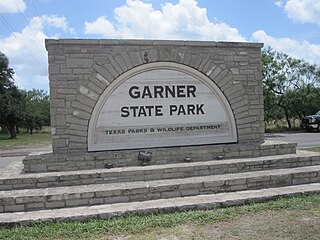
Garner State Park is a state park in the community of Concan, Texas located in Uvalde County, Texas in the United States. Garner State Park, in the Texas Hill Country, is the most popular state park in Texas for overnight camping. It often fills by noon in peak parts of the season. The park is popular with campers and local residents for its activities on the Frio River and the dances held nightly during the spring and summer.
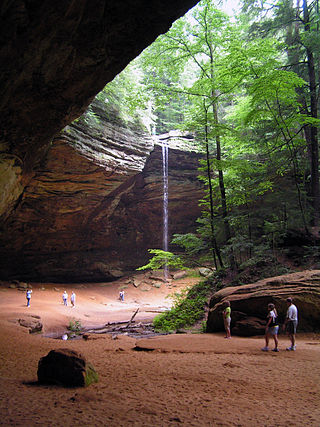
Hocking Hills State Park is a state park in the Hocking Hills region of Hocking County, Ohio, United States. In some areas the park adjoins the Hocking State Forest. Within the park are over 25 miles (40 km) of hiking trails, rock formations, waterfalls, and recess caves. The trails are open from dawn to dusk, all year round, including holidays.

The Guadalupe River runs from Kerr County, Texas, to San Antonio Bay on the Gulf of Mexico, with an average temperature of 17.75 degrees Celsius. It is a popular destination for rafting, fly fishing, and canoeing. Larger cities along it include Kerrville, New Braunfels, Seguin, Gonzales, Cuero, and Victoria. It has several dams along its length, the most notable of which, Canyon Dam, forms Canyon Lake northwest of New Braunfels.
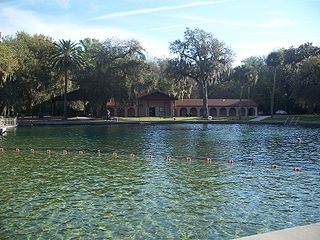
De Leon Springs State Park is a Florida State Park in Volusia County, Florida. It is located in DeLeon Springs, off CR 3.

Barton Creek is a tributary that feeds the Colorado River as it flows through the Texas Hill Country. The creek passes through some of the more scenic areas in Greater Austin, surrounded in many parts by a greenbelt of protected lands that serves as a habitat for many indigenous species of flora and fauna. The creek passes through Barton Creek Greenbelt and is fed by Barton Springs.

Colorado Bend State Park is a 5,328.3-acre (2,156 ha) state park located in the Hill Country region of the U.S. state of Texas, mostly in San Saba County. It was purchased by the state in 1984 and opened to the public in 1987. It is representative of the karst features typically seen in the Hill Country, with many sinkholes, caves, and springs.

The Edwards Aquifer is one of the most prolific artesian aquifers in the world. Located on the eastern edge of the Edwards Plateau in the U.S. state of Texas, it is the source of drinking water for two million people, and is the primary water supply for agriculture and industry in the aquifer's region. Additionally, the Edwards Aquifer feeds the Comal and San Marcos Springs, provides springflow for recreational and downstream uses in the Nueces, San Antonio, Guadalupe, and San Marcos river basins, and is home to several unique and endangered species.
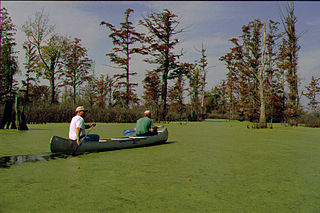
The Cache River is a 92-mile-long (148 km) waterway in southernmost Illinois, in a region sometimes called Little Egypt. The basin spans 737 square miles (1,910 km2) and six counties: Alexander, Johnson, Massac, Pope, Pulaski, and Union. Located at the convergence of four major physiographic regions, the river is part of the largest complex of wetlands in Illinois. The Cache River Wetlands is America's northernmost cypress/tupelo swamp and harbors 91 percent of the state's high quality swamp and wetland communities. It provides habitat for more than 100 threatened and endangered species in Illinois. In 1996, the Cache was designated a Wetland of International Importance by the Ramsar Convention.

Wekiwa Springs State Park is a 7,000-acre (28 km2) Florida State Park in Apopka, Florida. It is located 20 minutes north of Orlando, off Interstate 4 at exit 94, near Altamonte Springs and Longwood. The park also contains the head water of the Wekiva River. It also serves as the headquarters of one of the state's five AmeriCorps Florida State Parks chapters.

The Blanco River is a river in the Hill Country of Texas in the United States.
Wimberley Independent School District is a public school district based in Wimberley, Texas, United States. In addition to most of Wimberley, the district serves the city of Woodcreek. In addition to Hays County, it extends into Comal County.

Lake O’ the Pines is a reservoir on Big Cypress Bayou, also known as Big Cypress Creek, chiefly in Marion County, Texas, USA. The reservoir also occupies a small part of Upshur and Morris Counties. The dam is located approximately 8.5 miles (13.7 km) west of Jefferson.

The Eramosa Karst is a provincially significant Earth Science Area of Natural and Scientific Interest in Ontario, Canada, located in Stoney Creek, a constituent community of the City of Hamilton, and immediately south of the Niagara Escarpment.

San Marcos Regional Airport is a public use airport located in Caldwell County, Texas, United States. It is four nautical miles (7 km) east of the central business district of San Marcos, a city that is mostly in Hays County. The airport is owned by the City of San Marcos and operated by Texas Aviation Partners. It is located east of the border of Caldwell County and Hays County. Before it was operated as a civilian airport it was known as Gary Air Force Base.
The Lost River is a river that rises in Vernon Township, Washington County, Indiana, and discharges into the East Fork of the White River in Lost River Township, Martin County, Indiana. The river's unusual hydrology has led to two of its features being named as National Natural Landmarks.
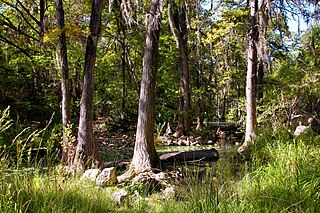
Honey Creek State Natural Area is a nature preserve of almost 2300 acres in western Comal County, Texas, United States. The Texas Parks and Wildlife Department acquired part of the natural area from the Nature Conservancy in 1985 and the rest from a private individual in 1988. Honey Creek opened in 1985 with access by guided tour only. Since Honey Creek is designated a "Natural Area" rather than a "State Park", the Texas Parks and Wildlife Department's first priority is the maintenance and preservation of the property's natural state.
{{cite web}}: CS1 maint: archived copy as title (link)